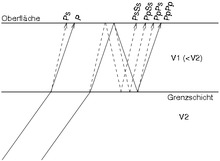Receiver functions
The receiver functions method is one of the most common evaluation methods in seismology . In its original version, in the mid-1960s, Fourier spectra of P waves were used to derive velocity structures from the response function of the earth's crust beneath a single seismic station. However, the method has been continuously developed since then and is now also routinely used in larger station networks.
The receiver functions method is based on the effect of partial conversion of seismic wave types (conversion), as occurs at seismic discontinuities : the energy of a P-wave hitting such a boundary layer is partly converted into an S-wave (referred to as Ps -Wave). Since their speed of propagation is lower, these so-called converted seismic phases reach the measuring station with a delay. The depth of the discontinuity can be deduced from the time difference with a suitable speed model. In addition to the directly converted phase, multiples also occur (waves reflected multiple times within a seismic layer and possibly converted in the process). On the one hand, these provide additional information about their transit time difference , but on the other hand they can also cover direct phases and thus have a disruptive effect.
In recent developments, the S-Receiver Functions method has also gained in importance. This is based on the same principle, but uses the opposite case of an S-wave, which is partially converted into P-waves (Sp-wave). Since the S wave is a later phase of the wave spectrum, a significantly higher noise level usually occurs here . The S-Receiver Function method, however, has the advantage that the Sp phases to be investigated arrive before the generating S wave due to the higher P wave velocity. The multiple phases, on the other hand, reach the measuring station later due to the multiple walking distance and therefore do not interfere with the directly converted phases.
Literature / sources
- T. Lay & TC Wallace: Modern Global Seismology , Academic Press, San Diego, 1995, ISBN 978-0127328706
- X. Yuan: Teleseismic Receiver Function Study and Its Application in Tibet and the Central Andes , Dissertation, 2000, Scientific Technical Report STR00 / 10, GFZ Potsdam
